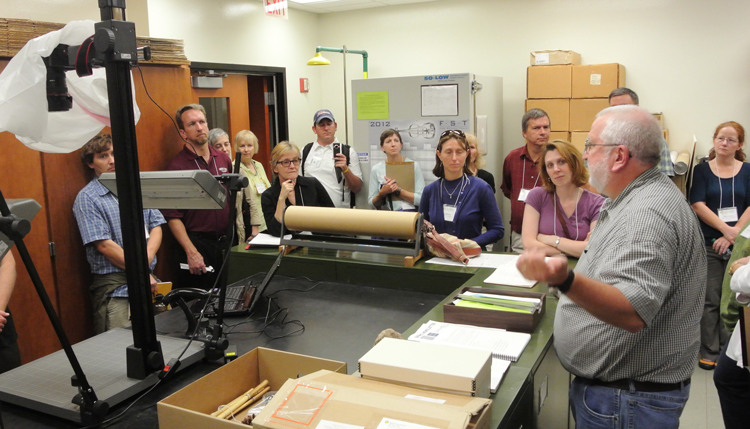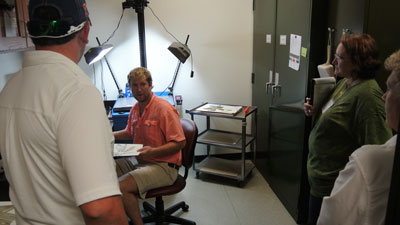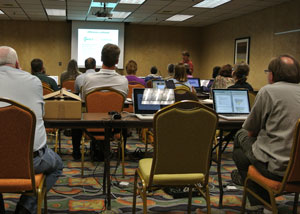
Thirty participants gathered at Valdosta State University September 16–18, 2012 for iDigBio’s first herbarium digitization workshop. About half of the diverse group represented institutions at the earliest stages of launching digitization programs. More experienced attendees sought strategies for refining their institution’s workflows, processes, and protocols. iDigBio extends special recognition and appreciation to Valdosta State for hosting the workshop, providing extensive on-site support, and for making technology available that ensured the workshop's success.
Participants were welcomed with a Sunday evening reception and dinner in the museum-like atrium of VSU’s Bailey Science Center, the home of the VSC herbarium. Professor and Herbarium Director Richard Carter, Dean of Arts and Sciences Connie Richards, biology department head Bob Gannon, and iDigBio PI Pam Soltis were on hand to welcome the group. Following dinner, Gil Nelson provided a brief overview of iDigBio and its mission.
Monday’s sessions focused largely on imaging and workflows. Following a brief introduction to global issues related to digitization tasks and components, Mike Bevans, Information Manager for Digitization at the New York Botanical Garden, filled the morning with a detailed and extensive session on imaging, image processing, and techniques for using image management software.  Following lunch and a short walk to the herbarium, participants rotated though several demonstration stations featuring two camera systems, various data entry protocols, and a database-driven herbarium label creation strategy. VSU student technicians and workshop facilitators provided commentary at each station.
Following lunch and a short walk to the herbarium, participants rotated though several demonstration stations featuring two camera systems, various data entry protocols, and a database-driven herbarium label creation strategy. VSU student technicians and workshop facilitators provided commentary at each station.
End-of-day socializing continued into the evening at Guilio’s Restaurant, which is normally closed on Mondays but opened especially and solely for iDigBio workshop participants.
Tuesday served as “database day.” Joanna McCaffrey kicked off the sessions with criteria for evaluating software, followed by Herrick Brown’s hands-on sessions featuring Specify and Symbiota. Thanks to assistance from the Specify team, which configured 30 instances of Specify for remote connection, workshoppers were afforded the opportunity to gain real time experience with the Specify software.  Prior to the workshop, and thanks to considerations offered by Zack Murrell, Herrick created a Symbiota portal on Appalachian State University’s infrastructure expressly configured to provide participants with the opportunity to manipulate the portal, upload data, and evaluate the software for possible adoption. Afternoon topics included georeferencing and the use of GeoLocate’s collaborative tools, presented by Gil Nelson, consideration of pre- and post-digitization including methods and criteria for moving data and images to the web, presented by Deb Paul, and an overview of KE’s EMu software, conducted by Joanna McCaffrey.
Prior to the workshop, and thanks to considerations offered by Zack Murrell, Herrick created a Symbiota portal on Appalachian State University’s infrastructure expressly configured to provide participants with the opportunity to manipulate the portal, upload data, and evaluate the software for possible adoption. Afternoon topics included georeferencing and the use of GeoLocate’s collaborative tools, presented by Gil Nelson, consideration of pre- and post-digitization including methods and criteria for moving data and images to the web, presented by Deb Paul, and an overview of KE’s EMu software, conducted by Joanna McCaffrey.
At the conclusion of the second day of the workshop, Richard Carter treated the more intrepid among the group to a late afternoon field trip to a well-managed, intact longleaf pineland near Valdosta. Participants from locations outside of the Southeastern Coastal Plains were especially appreciative of the opportunity to visit this endangered habitat type, explore its rich herbaecous ground cover, and to learn about one of the most important of South Georgia's signature natural communities.
iDigBio staff will solicit electronic feedback immediately following the workshop to assess the usefulness of workshop activities and to learn how to increase the effectiveness of future digitization training workshops.







